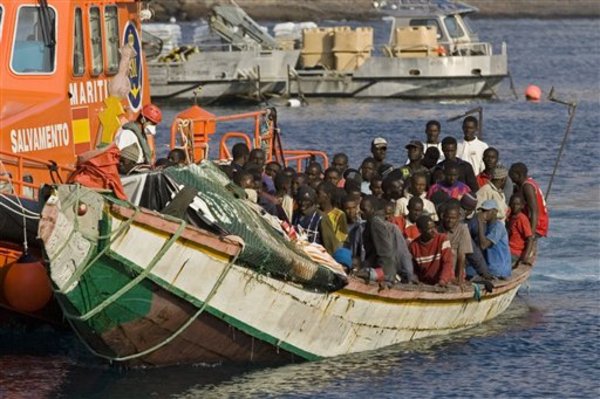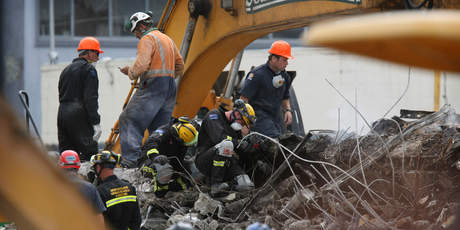A 7.4-magnitude earthquake has struck off the coast of Guatemala, killing "around 10" people, causing panicked evacuations as far as Mexico City and a tsunami alert in El Salvador.
The victims died in the Guatemalan town of San Pedro Sacatepequez, some 250 kilometres west of the capital Guatemala City.
"Reports from colleagues in the area indicate that there are around 10 dead," firefighters' spokesman Sergio Vazquez said.
Communication was difficult in the area because phone lines fell and several places were without power, Vazquez said.
The Guatemalan national disaster response agency (Conred) had confirmed only one death.
In El Salvador, the president ordered people in a coastal area to evacuate their homes over fears of a potential tsunami.
The US Geological Survey said the quake struck some 24 kilometres south of Champerico, Guatemala and 163 kilometres west-southwest of Guatemala City. The depth was 41.6 kilometres.
The Mexican Seismological Service said nine aftershocks followed the quake, which it put at a magnitude of 7.3, some 68 kilometres southwest of Ciudad Hidalgo in the state of Chiapas.
The quake was strongly felt in Guatemala City and southern Mexico, prompting scenes of panic across the region. People streamed out of homes, schools and office buildings as far north as Mexico City.
"We just had an earthquake," Mexico City Mayor Marcelo Ebrard wrote on Twitter.
"It was intense in a good part of the city,'' he said, adding later that the quake did not cause any damage in the sprawling metropolis of 20 million people.
One Mexico City metro line was briefly suspended but Ebrard reported moments later that the system was back running normally.
Buildings were also evacuated in the southern Mexican states of Oaxaca and Chiapas, without reports of damage or victims.
"I was scared. It was horrible," Uvita Mena, who lives in the Chiapas town of Tuxtla Gutierrez, told AFP.
The USGS had initially measured the quake at 7.5 magnitude.
The Pacific Tsunami Warning Center said there was no destructive widespread tsunami threat, but Salvadoran President Mauricio Funes ordered evacuations in Puerto de la Libertad and other western coastal towns.
"This country is constantly exposed to threats ... and this time the threat is a tsunami on the Salvadoran coast, especially the western beaches,'' Funes said.
The Salvadoran Environment Observatory issued a tsunami alert for the west coast departments of Ahuachapan and Sonsonate.
"We are not talking about a tsunami of a large magnitude," observatory spokeswoman Daysi Lopez said, adding that it would be very localized.
The event came two months after a 7.6-magnitude earthquake rocked Costa Rica, without causing any casualties or injuries.
Wednesday 7 November 2012
http://www.nzherald.co.nz/world/news/article.cfm?c_id=2&objectid=10845880
The victims died in the Guatemalan town of San Pedro Sacatepequez, some 250 kilometres west of the capital Guatemala City.
"Reports from colleagues in the area indicate that there are around 10 dead," firefighters' spokesman Sergio Vazquez said.
Communication was difficult in the area because phone lines fell and several places were without power, Vazquez said.
The Guatemalan national disaster response agency (Conred) had confirmed only one death.
In El Salvador, the president ordered people in a coastal area to evacuate their homes over fears of a potential tsunami.
The US Geological Survey said the quake struck some 24 kilometres south of Champerico, Guatemala and 163 kilometres west-southwest of Guatemala City. The depth was 41.6 kilometres.
The Mexican Seismological Service said nine aftershocks followed the quake, which it put at a magnitude of 7.3, some 68 kilometres southwest of Ciudad Hidalgo in the state of Chiapas.
The quake was strongly felt in Guatemala City and southern Mexico, prompting scenes of panic across the region. People streamed out of homes, schools and office buildings as far north as Mexico City.
"We just had an earthquake," Mexico City Mayor Marcelo Ebrard wrote on Twitter.
"It was intense in a good part of the city,'' he said, adding later that the quake did not cause any damage in the sprawling metropolis of 20 million people.
One Mexico City metro line was briefly suspended but Ebrard reported moments later that the system was back running normally.
Buildings were also evacuated in the southern Mexican states of Oaxaca and Chiapas, without reports of damage or victims.
"I was scared. It was horrible," Uvita Mena, who lives in the Chiapas town of Tuxtla Gutierrez, told AFP.
The USGS had initially measured the quake at 7.5 magnitude.
The Pacific Tsunami Warning Center said there was no destructive widespread tsunami threat, but Salvadoran President Mauricio Funes ordered evacuations in Puerto de la Libertad and other western coastal towns.
"This country is constantly exposed to threats ... and this time the threat is a tsunami on the Salvadoran coast, especially the western beaches,'' Funes said.
The Salvadoran Environment Observatory issued a tsunami alert for the west coast departments of Ahuachapan and Sonsonate.
"We are not talking about a tsunami of a large magnitude," observatory spokeswoman Daysi Lopez said, adding that it would be very localized.
The event came two months after a 7.6-magnitude earthquake rocked Costa Rica, without causing any casualties or injuries.
Wednesday 7 November 2012
http://www.nzherald.co.nz/world/news/article.cfm?c_id=2&objectid=10845880







